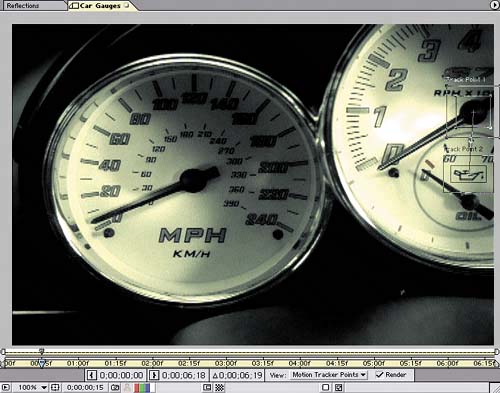| Now that you've created the first reflection, creating the second reflection for the RPM gauge should go smoothly. You won't be able to copy and paste the values from the first reflection because, among other things, the duration and image size are different. Instead, you'll use the same process you used to create the first reflection (you'll use a different process for the third reflection later in this chapter): 1. | Add the Model.jpg file from the Project window to the Reflections Timeline at time 0;00, and set the layer's Opacity to 50%.
| 2. | Go to time 3;00, and position the Model layer so that it's centered over the RPM gauge.
| 3. | Use the Elliptical Mask tool on the Model layer to draw a circle around the white face of the RPM gauge.
| 4. | Set the mask's Mode to Add and Feather to 50, 50.
|
Masking the Model layer over the RPM gauge  Animating the second reflection You'll animate the second reflection using the same methods you used to animate the first reflection. This time, though, you'll track different points on the Car Gauges layer and add a second tracker to the layer: 1. | Double-click the Car Gauge layer in the Timeline to open it in a layer.
| 2. | Go to time 0;15, and click the Set In Point button  in the Car Gauges window. in the Car Gauges window.
| 3. | Go to time 6;00, and click the Set Out Point button in the Layer window. This is the last frame before the image goes past the edge of the comp.
| 4. | Choose Animation > Track Motion, and make sure Position and Scale are turned on in the Tracker Controls palette.
Expand the Car Gauges layer and its Motion Trackers group in the Timeline and note that the layer has two trackers now: the tracker that you used to track motion for the first reflection you created, and the tracker you just created for the second reflection.
Tip To make it easier to distinguish the current tracker from the tracker you used for the first reflection, rename each tracker in the Timeline. To rename a tracker, click the tracker's name in the Timeline, press Enter on your keyboard, and then type a unique name. | 5. | Move Track Point 1 over the black center dial of the RPM gauge.
| 6. | Place Track Point 2 over the picture of the oil can on the gauge. Adjust the search and feature regions of each Track Point as needed.
Aligning the tracker for the second reflection  | 7. | Click the Edit Target button in the Tracker Controls palette, choose Model.jpg from the Layer menu, and click OK.
| 8. | Click the Analyze Forward button in the Tracker Controls palette.
Just as before, pay attention to the feature region (inner box) of each Track Point; if a Track Point starts drifting away from the area it was originally tracking, click Analyze 1 Frame Backward until you reach the frame where the drifting started, and then adjust the feature region so it's over a better area to track. After adjusting the feature region, click the Analyze Forward button again to replace the drifting points in the motion path.
| 9. | Once you're satisfied with the motion path, click Apply in the Tracker Controls palette, choose X And Y in the options dialog, and then click OK.
If you expand the Model layer in the Timeline, you'll see the Scale and Position keyframes that the motion tracker added.
| 10. | Adjust the Model layer's Anchor Point in the Timeline so that the image lies in the middle of the RPM gauge.
| 11. | To fade in the Model layer, add a 0% Opacity keyframe to the layer at time 0;00, and change the layer's Opacity at time 1;00 to 40%.
| 12. | To fade out the layer, add another 40% Opacity keyframe at time 4;15, and then go to time 6;00 and change the layer's Opacity to 0%.
|
Click the Ram Preview button in the Time Controls palette to see the results. |

